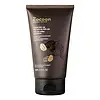What's inside
What's inside
 Key Ingredients
Key Ingredients

 Benefits
Benefits

 Concerns
Concerns

 Ingredients Side-by-side
Ingredients Side-by-side

Water
Skin ConditioningKaolin
AbrasiveButylene Glycol
HumectantGlycerin
HumectantArtemisia Vulgaris Extract
Skin ConditioningDiglycerin
HumectantMica
Cosmetic ColorantPEG-32
HumectantSodium Palmitate
CleansingGlyceryl Polymethacrylate
Pvm/Ma Copolymer
Emulsion StabilisingCeramide EOP
Skin ConditioningCeramide AP
Skin ConditioningCeramide Ns
Skin ConditioningCeramide As
Skin ConditioningCeramide NP
Skin ConditioningCI 77289
Cosmetic ColorantPhenoxyethanol
PreservativePEG-40 Hydrogenated Castor Oil
EmulsifyingCI 77492
Cosmetic ColorantMenthyl Lactate
MaskingBeta-Glucan
Skin ConditioningCurcuma Longa Root Extract
MaskingVerbascum Thapsus Extract
Skin ConditioningNiacinamide
SmoothingCentella Asiatica Extract
CleansingSalicylic Acid
MaskingPinus Densiflora Leaf Extract
AntimicrobialLactobacillus Ferment Lysate
Skin ConditioningSaccharide Isomerate
HumectantHydroxypropyl Cyclodextrin
MaskingDipropylene Glycol
HumectantRhamnose
Humectant1,2-Hexanediol
Skin ConditioningWater, Kaolin, Butylene Glycol, Glycerin, Artemisia Vulgaris Extract, Diglycerin, Mica, PEG-32, Sodium Palmitate, Glyceryl Polymethacrylate, Pvm/Ma Copolymer, Ceramide EOP, Ceramide AP, Ceramide Ns, Ceramide As, Ceramide NP, CI 77289, Phenoxyethanol, PEG-40 Hydrogenated Castor Oil, CI 77492, Menthyl Lactate, Beta-Glucan, Curcuma Longa Root Extract, Verbascum Thapsus Extract, Niacinamide, Centella Asiatica Extract, Salicylic Acid, Pinus Densiflora Leaf Extract, Lactobacillus Ferment Lysate, Saccharide Isomerate, Hydroxypropyl Cyclodextrin, Dipropylene Glycol, Rhamnose, 1,2-Hexanediol
Water
Skin ConditioningCoffea Arabica Seed Powder
AbrasiveCetearyl Alcohol
EmollientCocamidopropyl Betaine
CleansingCarthamus Tinctorius Seed Oil
MaskingGlyceryl Stearate
EmollientC15-19 Alkane
SolventGlycerin
HumectantCeteareth-20
CleansingCeteareth-12
EmulsifyingTheobroma Cacao Seed Butter
EmollientButyrospermum Parkii Butter
Skin ConditioningC10-18 Triglycerides
EmollientOlus Oil
EmollientCetyl Palmitate
EmollientGlycine Soja Sterols
EmollientPhospholipids
Skin ConditioningGlycolipids
Skin ConditioningHydroxypropyl Starch Phosphate
Glycine Soja Oil
EmollientSodium Stearoyl Glutamate
CleansingAcrylates/C10-30 Alkyl Acrylate Crosspolymer
Emulsion StabilisingTocopherol
AntioxidantXanthan Gum
EmulsifyingPhenoxyethanol
PreservativeSodium Hydroxide
BufferingEthylhexylglycerin
Skin ConditioningTrisodium Ethylenediamine Disuccinate
Water, Coffea Arabica Seed Powder, Cetearyl Alcohol, Cocamidopropyl Betaine, Carthamus Tinctorius Seed Oil, Glyceryl Stearate, C15-19 Alkane, Glycerin, Ceteareth-20, Ceteareth-12, Theobroma Cacao Seed Butter, Butyrospermum Parkii Butter, C10-18 Triglycerides, Olus Oil, Cetyl Palmitate, Glycine Soja Sterols, Phospholipids, Glycolipids, Hydroxypropyl Starch Phosphate, Glycine Soja Oil, Sodium Stearoyl Glutamate, Acrylates/C10-30 Alkyl Acrylate Crosspolymer, Tocopherol, Xanthan Gum, Phenoxyethanol, Sodium Hydroxide, Ethylhexylglycerin, Trisodium Ethylenediamine Disuccinate
 Reviews
Reviews

Ingredients Explained
These ingredients are found in both products.
Ingredients higher up in an ingredient list are typically present in a larger amount.
Glycerin is already naturally found in your skin. It helps moisturize and protect your skin.
A study from 2016 found glycerin to be more effective as a humectant than AHAs and hyaluronic acid.
As a humectant, it helps the skin stay hydrated by pulling moisture to your skin. The low molecular weight of glycerin allows it to pull moisture into the deeper layers of your skin.
Hydrated skin improves your skin barrier; Your skin barrier helps protect against irritants and bacteria.
Glycerin has also been found to have antimicrobial and antiviral properties. Due to these properties, glycerin is often used in wound and burn treatments.
In cosmetics, glycerin is usually derived from plants such as soybean or palm. However, it can also be sourced from animals, such as tallow or animal fat.
This ingredient is organic, colorless, odorless, and non-toxic.
Glycerin is the name for this ingredient in American English. British English uses Glycerol/Glycerine.
Learn more about GlycerinPhenoxyethanol is a preservative that has germicide, antimicrobial, and aromatic properties. Studies show that phenoxyethanol can prevent microbial growth. By itself, it has a scent that is similar to that of a rose.
It's often used in formulations along with Caprylyl Glycol to preserve the shelf life of products.
Water. It's the most common cosmetic ingredient of all. You'll usually see it at the top of ingredient lists, meaning that it makes up the largest part of the product.
So why is it so popular? Water most often acts as a solvent - this means that it helps dissolve other ingredients into the formulation.
You'll also recognize water as that liquid we all need to stay alive. If you see this, drink a glass of water. Stay hydrated!
Learn more about Water